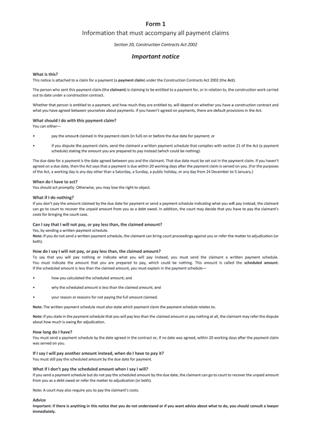
6 minute read
Why you should be using Payment Claims
When you do building work for clients, you invoice them from time to time. Sometimes, your clients do not pay those invoices, either because they cannot, or they do not believe they should.
There are various ways in which you can make them pay you, or at least resolve the underlying dispute that is causing them not to pay you. Those methods range from negotiation, mediation, Disputes Tribunal claims, adjudication, arbitration, and suing in the courts. Because none of them is perfect, you may as well take advantage of everything that is available to you. And there is one more option that you can use if you make the effort, and that is to turn your invoices into payment claims under the Construction Contracts Act (the “CCA”). You’re mad if you don’t.
Advertisement

Why? Because payment claims are like invoices on steroids. They have super powers that ordinary invoices don’t have. Parliament intended it that way, because Parliament was concerned that it was too easy for unscrupulous clients to withhold money from the contractors and subcontractors below them, based on fictitious reasons. So, in 2002 Parliament introduced this new method to force them to either pay up or explain why not.
What you do is, you take your invoice and you modify the wording of it so that it becomes a CCA payment claim. Then you “serve it” on your client. They have to respond to it with a payment schedule by a certain deadline. That payment schedule has to say how much of the claim they will pay. If it is not 100% of the claim, they have to say why. Then they have to pay the amount that they promised, by the due date. And if they do not respond by the deadline, they have to pay 100% regardless. What if they do not pay? You can sue them in court and recover your legal costs off them. It is a process known as summary judgment, so it is quicker and cheaper than most court cases. Having said that, no court case is quick, and no court case is cheap, so you may be wondering why you would bother. The answer is that once they are served with court papers, they take it seriously, and they consult a lawyer. Their lawyer will look at the situation, and if you have done everything right, the lawyer will advise your clients that they are likely to lose. Faced with that, they generally pay up promptly, to avoid losing in court and having to pay not only their own legal fees, but yours as well.
It does not matter if they have a counterclaim against you. They cannot even raise it in these proceedings. It is a “pay now, argue later” system, and it is all about who gets to have the money in the short term. The underlying dispute can then be resolved afterwards, and if the clients are on solid ground, they may well claw some or all of that money back from you. But in the meantime, you can use it to pay your subcontractors and suppliers, and your legal fees for that matter. And you will have given your clients a taste of defeat, and undermined their confidence a little, making it all the more likely that you will be able to negotiate a satisfactory settlement of the dispute.
Turning your invoices into payment claims To turn your invoices into payment claims, there are nine criteria in the CCA you have to satisfy. Some are easy, but others require more effort. Once you’ve got the hang of it you’ll be okay, but you must not cut corners and you must not be lazy. The idea is to explain very clearly what you are claiming and why.
Nine criteria to turn your invoice into a payment claim:
1. 2.
3.
4.
5.
6. 7. 8.
9. It must be in writing It must say “This is a payment claim under the Construction Contracts Act 2002” It must identify the relevant construction contract It must identify the construction work you are charging for It must identify the period of time during which the work took place It must state a claimed amount It must state the due date for payment It must indicate the manner in which the claimed amount was calculated And it must have “Form 1” attached to it
You will need a bit of help to get it right at the outset, and you will need to keep up with any law changes that affect payment claims. New Zealand Certified Builders (NZCB) can help you with both of those. The important point is, this is one of those situations where you need to get it 100% right. There is no point in spending thousands of dollars and waiting months for a Court hearing, only to have the Court throw out your payment claim because you did not comply with all nine requirements.
You are supposed to “serve” your payment claim on your clients in the proper manner. If you are using NZCB building contracts, then email is the best way. But you can also personally deliver it, post it to the clients’ usual or last known place of residence or business or leave it there instead, or fax it. Whatever method you use, make sure you have evidence of having done it, so your clients cannot later deny they received it.
Once you have served your payment claim, your clients have the opportunity to give you a payment schedule in response, but it is amazing how often they miss the deadline even though Form 1 spells it out in no uncertain terms. The deadline for a payment schedule is 20 working days after the payment claim is served, unless the building contract says something else. NZCB contracts say 5 working days, Master Builders contracts say 10, and NZIA and NZ Standards contracts have longer periods.
Even if your clients make the deadline, their payment schedule may not be valid. There are six criteria they have to satisfy, and they are:
1. It must be in writing 2. It must identify the payment claim to which it relates 3. It must state the amount that they propose to pay 4. It must indicate the manner in which they calculated that amount 5. It must indicate their reason or reasons for the difference 6. Where the difference is because they are withholding payment on any basis, it must indicate their reason or reasons Finally, just be aware that payment claims can also be used against you – by your subcontractors. So, watch for the words “payment claim” on all incoming invoices, and train your staff to look for this immediately on receipt. Make sure you know what deadlines apply to each subcontract, because it may not necessarily be the CCA 20 working days. Have a payment schedule template ready to be completed, and send a payment schedule each time, even if the payment claim is repeated. For more information on turning an Invoice into a Payment Claim using Xero or MYOB accounting programmes, check out the ‘Chew the Fat: Payment Claims’ video under the ‘Training – Chew The Fat’ section of the members’ Toolshed.
Geoff Hardy is a partner in the Auckland law firm Martelli McKegg and is a construction law specialist. Contact Geoff on (09) 379 0700 or geoff@martellimckegg.co.nz. This article is not intended to be relied upon as legal advice.









